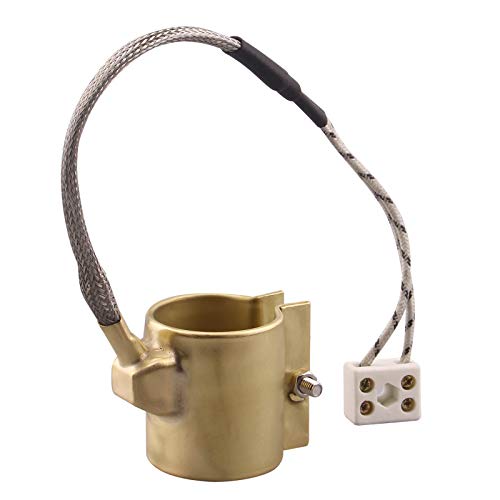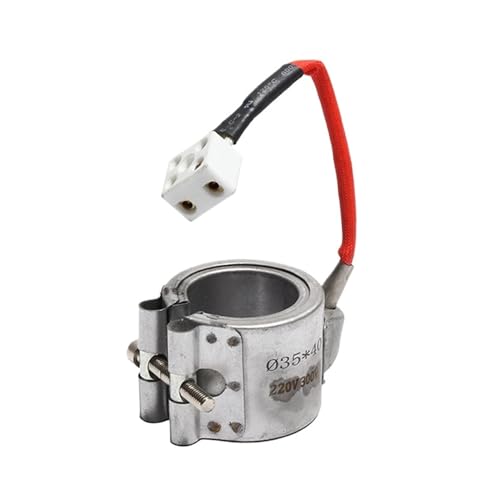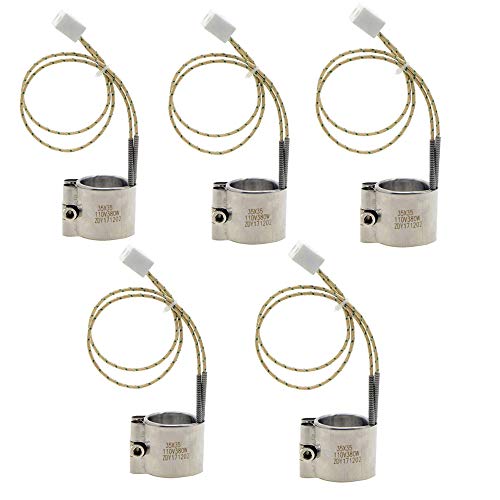Choosing the right ceramic band heater can impact temperature control, cycle times, and part quality in injection molding. Below is a quick comparison of five commonly used band heaters selected for compatibility with small to mid-size barrels and hot runner nozzles. Each product section includes image, features, and practical notes to help you compare technical fit and construction.
| Product | Voltage / Power | Band Size (ID x H) | Notable Feature |
|---|---|---|---|
| DERNORD 250W Band Heater | 110V / 250W | 35mm x 45mm | Brass band, ceramic wire connection |
| Nxtop 380W Band Heater (2-Pack) | 110V / 380W | 35mm x 35mm | Rust-resistant steel sheath, clamp lock |
| YXQ 380W Band Heater (2-Pack) | 110V / 380W | 35mm x 35mm | Steel sheath, notched sleeve for installation |
| HEXEH 300W Ceramic Band Heater | 110V / 300W (model options) | 32mm x 32mm | Aluminium plate cover, ceramic construction |
| Saim 380W Band Heater (5-Pack) | 110V / 380W | 35mm x 35mm | Braid lead length ~31cm, clamp lock |
Content Navigation
- DERNORD 110V 250W 35x45mm Brass Ceramic Band Heater
- Nxtop 110V 380W 35x35mm Injected Mould Band Heater (2-Pack)
- YXQ 110V 380W 35x35mm Band Heater (2Pcs)
- HEXEH 300W 32x32mm Ceramic Band Heater With Aluminium Plate Cover
- Saim 110V 380W 35x35mm Injected Mould Band Heater (5-Pack)
- Buying Guide: How To Choose A Ceramic Heater Band
DERNORD 110V 250W 35x45mm Brass Ceramic Band Heater

This DERNORD band heater is specified at 110V and 250W with a band size of 35mm inner diameter by 45mm height. The construction lists a brass band combined with a ceramic wire connection, which can offer improved insulation at higher junction temperatures compared with plain mica or fibrous lead exits.
Wire length is indicated at 255mm, suitable for routing in compact setups. The brass exterior may provide good contact and corrosion resistance in less aggressive environments, and the ceramic connection helps electrical isolation. Assess compatibility with your barrel or nozzle OD and mounting clamp method before ordering.
Nxtop 110V 380W 35x35mm Injected Mould Band Heater (2-Pack)

The Nxtop set provides 380W at 110V with a compact band profile of 35 x 35mm. The listed features emphasize a rust-resistant steel sheath and a stainless steel clamp type lock-up, which aids secure mounting and even radial compression.
Call 888-896-7031 for Free Local HVAC Quotes – Compare and Save Today!
A notched sleeve is specified to allow easier installation and to sit flush with nozzle hex surfaces. The design targets plastic injection heating applications for barrels or nozzles where a tighter, higher-wattage heater is required. For small-diameter barrels, verify the inner diameter match and clamp torque limits to prevent deformation.
YXQ 110V 380W 35x35mm Band Heater (2Pcs)

YXQ’s 380W band heater mirrors several specs of other 35x35mm units: steel sheath, stainless clamp, and a notched sleeve for alignment. The product is noted as intended for injection molding container heating, emphasizing industrial use.
Common strengths of this style include even radial heat distribution from the sheath and secure mechanical retention via the clamp. Confirm lead routing, terminal type, and whether a single- or dual-lead configuration matches your controller and sensor layout prior to installation.
HEXEH 300W 32x32mm Ceramic Band Heater With Aluminium Plate Cover

HEXEH lists a product described as a ceramic band heater with an aluminium plate cover, offering a 32 x 32mm band intended for cylindrical heating in industrial contexts. The listing highlights durable materials and suitability for factory production lines.
Call 888-896-7031 for Free Local HVAC Quotes – Compare and Save Today!
Ceramic construction generally provides higher maximum operating temperatures and improved dielectric properties versus mica-based bands. The aluminium plate cover can assist heat spreading and mechanical protection. Check the exact voltage option and screw/terminal type for compatibility with your electrical system.
Saim 110V 380W 35x35mm Injected Mould Band Heater (5-Pack)

Saim supplies a bulk pack of five 380W band heaters sized 35 x 35mm. Features include a rust-resistant steel sheath, stainless clamp lock-up, and a braided lead length of approximately 31cm, which can simplify routing to controllers or junction boxes.
Bulk packaging can fit maintenance schedules where multiple replacement elements are needed. Evaluate the lead terminations and thermal cycling ratings; for frequent changeouts, clamp style and sheath flatness impact repeatability of thermal contact.
Buying Guide: How To Choose A Ceramic Heater Band
Selecting the right band heater involves matching mechanical dimensions, electrical ratings, material properties, and installation methods. Below are purchase considerations and comparison perspectives to help match a heater to your injection molding application.
1. Dimension And Fit
- Inner Diameter (ID) — Must match the barrel or nozzle OD to ensure radial contact; too loose reduces conduction, too tight risks deformation.
- Height (H) — Determines the heated zone length; longer heaters distribute heat across a bigger section of the barrel.
- Notches And Sleeve Type — Notched sleeves or flush designs allow seating around nozzle hexes or to accommodate set screws.
2. Electrical Rating And Watt Density
- Voltage And Wattage — Choose heaters that match your supply (110V, 220V, etc.) and required heating rate. Higher watt density heats faster but can risk hotspots.
- Watt Density — Expressed as W/cm² or W/in²; lower density is gentler for plastics with narrow processing windows.
3. Construction Materials
- Ceramic Core vs Mica — Ceramic cores offer higher temperature tolerance and better insulation; mica is often lower cost and thinner.
- Sheath Material — Stainless or rust-resistant steel provides corrosion resistance; brass or aluminium can offer better contact but vary by environment.
- Cover Plates — Aluminium or metal covers protect elements and spread heat more evenly across the band.
4. Connection Type And Wire Exits
- Lead Length And Braid — Longer braided leads simplify routing; braided leads also resist abrasion.
- Ceramic Wire Connections — Provide improved electrical insulation and stability at elevated temperatures compared with simple exposed terminals.
- Terminal Type — Ensure the terminal matches your sensors or controllers; some units require ring terminals, others quick-disconnects.
5. Mounting And Clamping
- Clamp Style — Stainless steel clamp locks give secure radial pressure; clamping torque should be controlled to avoid deforming the heater or barrel.
- Repeatability — For heaters replaced frequently, choose designs that maintain flat contact surfaces and use clamps that reproduce tightness consistently.
6. Thermal Performance And Control
- Uniform Heat Transfer — A full sheath and a flat mating surface reduce thermal gradients.
- Compatibility With Sensors — Ensure thermocouple or RTD placement and controller interfaces are compatible with the heater and process requirements.
- Cycling Durability — Consider products rated for frequent thermal cycling if the process includes many starts and stops.
7. Environmental And Application Considerations
- Corrosive Environments — Stainless steel sheath and stainless clamps are more resistant to humidity and corrosive agents.
- Industrial Usage — For continuous production lines, select heaters with proven material longevity and consistent lead termination protection.
- Size Variants — Confirm whether the product supports alternative voltages or heights if you need flexibility across machines.
8. Maintenance And Replacement Strategy
- Spare Parts — Keep matched spares for rapid swap-outs to reduce downtime.
- Batch Consistency — When replacing multiple heaters on the same machine, use the same part number to maintain consistent thermal profiles.
- Inspection Points — Regularly inspect sheath flatness, clamp corrosion, and lead insulation for early signs of failure.
Comparison Perspectives
- Small-Diameter, Higher Precision Nozzles — Prefer ceramic-core or aluminium-covered bands for uniform heat and minimal cold zones.
- Higher Power Needs — 380W units provide faster heat-up for larger mass but require attention to watt density and heat control.
- Durability And Environment — Stainless sheath and longer braided leads improve longevity under industrial conditions.
- Installation Ease — Notched sleeves and clamp lock designs improve fit and make installation faster while maintaining contact pressure.
When comparing options, map your barrel OD, required heated length, controller voltage, and thermal cycling expectations to the heater’s specifications. Prioritize matching ID and watt density first, then refine by sheath material and connection type for reliable, long-term operation.
Tips for Getting the Best HVAC Prices
- Prioritize Quality Over Cost
The most critical factor in any HVAC project is the quality of the installation. Don’t compromise on contractor expertise just to save money. - Check for Rebates
Always research current rebates and incentives — they can significantly reduce your overall cost. - Compare Multiple Quotes
Request at least three estimates before making your choice. You can click here to get three free quotes from local professionals. These quotes include available rebates and tax credits and automatically exclude unqualified contractors. - Negotiate Smartly
Once you've chosen a contractor, use the proven strategies from our guide — How Homeowners Can Negotiate with HVAC Dealers — to get the best possible final price.
